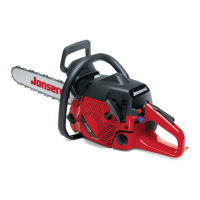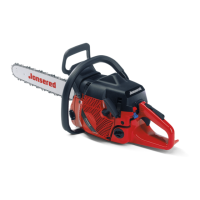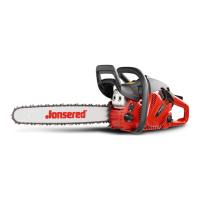Do you have a question about the Jonsered CS 2152 EPA III and is the answer not in the manual?
Lists safety and operational symbols found on the chain saw itself, including warnings and specific features.
Explains symbols used within the manual to denote instructions, warnings, cautions, and required actions.
Identifies and explains various labels and decals affixed to the chain saw for safety, compliance, and identification.
A welcoming message from Jonsered, congratulating the customer and emphasizing the manual's importance for long-term use.
Identifies and labels all major components of the chain saw using a diagram for user reference and understanding.
Essential pre-operation checks and preparations required before using the chain saw for the first time.
Critical safety advice and warnings regarding chain saw operation, use, and maintenance.
Emphasizes user judgment, caution, and seeking expert advice when uncertain about procedures.
Details the mandatory personal protective equipment (PPE) required for safe chain saw operation.
Explains the function of the chain saw's built-in safety features and the necessity of their maintenance.
Describes the chain brake and front hand guard as crucial safety features designed to prevent kickback and accidents.
Explains the function of the throttle lockout mechanism to prevent accidental throttle engagement.
Describes the chain catcher's role in preventing injury by retaining a broken or jumped saw chain.
Details the function of the right hand guard, protecting the user's hand and preventing interference.
Explains the vibration damping system designed to reduce operator fatigue and discomfort during use.
Provides essential information on understanding the causes of kickback and implementing techniques to avoid it.
Guides on selecting and maintaining cutting equipment for optimal safety and performance.
Explains the function and operation of the stop switch for safely turning off the engine.
Describes the muffler's role in noise reduction and exhaust management, including safety warnings.
Details specific cutting equipment features that help minimize the risk of kickback.
Defines terms and specifications related to the guide bar, including its nose radius.
Defines terms and specifications related to the saw chain, including link types and pitch.
Explains key terminology used to describe bar and chain specifications for maintenance and selection.
Provides guidance on sharpening chain teeth and adjusting the depth gauge for optimal cutting performance.
Details the correct tools and procedures for sharpening the cutting teeth of the saw chain.
Offers practical advice for properly adjusting the depth gauge setting of the saw chain.
Provides a step-by-step guide for adjusting the depth gauge setting using specific tools and techniques.
Explains the importance and procedure for correctly tensioning the saw chain to ensure safe operation.
Emphasizes the critical importance of proper lubrication for cutting equipment to prevent damage and injury.
Discusses the properties of chain oil, recommended types, and warnings against using unsuitable oils.
Details the process for filling the chain oil tank and the operation of the automatic lubrication system.
Explains how to verify that the chain lubrication system is functioning correctly and effectively.
Describes the types of chain drive sprockets and the importance of regular checks and replacement.
Advises on the necessary regular lubrication of the needle bearing located in the clutch drum.
Outlines daily checks for wear and damage on the saw chain, rivets, and links.
Provides detailed instructions for correctly fitting the guide bar and saw chain onto the chain saw.
Explains the correct fuel specifications, mixing ratios, octane requirements, and the use of unleaded gasoline.
Offers guidance on the proper procedures for running in a new chain saw engine to ensure longevity.
Recommends specific Jonsered two-stroke oil and warns against using oil intended for other engine types.
Recommends the use of special chain oil and provides warnings against using waste or unsuitable oils.
Details crucial safety precautions and the correct procedures for refueling the chain saw.
Highlights essential safety measures related to fuel and vapor, emphasizing fire and explosion risks.
Provides guidelines for safely transporting and storing the chain saw and its fuel.
Offers instructions for preparing the machine for extended periods of storage to maintain its condition.
Outlines essential safety notes and preliminary checks required before starting the chain saw.
Details the specific steps for starting a cold engine, including choke and brake engagement.
Explains the function and proper use of the decompression valve to facilitate engine starting.
Describes the procedure for starting a warm engine, noting differences from the cold start process.
Explains the correct procedure for safely stopping the chain saw engine using the stop switch.
Lists essential pre-operation checks for the chain saw's safety features and overall functionality.
Provides fundamental safety rules and critical information for the correct operation of a chain saw.
Offers general guidelines for safe chain saw operation, including proper grip, stance, and hazard awareness.
Explains fundamental techniques for safe and effective cutting with a chain saw, including cutting from above and below.
Provides specific guidance on safely cutting branches from a felled tree using appropriate techniques.
Details safe procedures for cutting logs, addressing risks associated with tension, support, and ground contact.
Introduces the principles and experience required for safely felling trees, with warnings for inexperienced users.
Specifies the mandatory safe distance to maintain from a tree during the felling operation.
Explains how to determine and control the felling direction of a tree for safe and efficient cutting.
Outlines steps for preparing the felling area and planning a safe retreat path.
Warns against felling trees larger than the bar length without specialized training and experience.
Explains the process of making directional cuts to control the tree's felling direction.
Details how to make the final felling cut and the importance of the felling hinge for directional control.
Provides advice on safely handling a fallen tree that is trapped or under tension.
Guides on how to safely cut materials that are under tension, preventing dangerous springback.
Provides essential information on understanding the causes of kickback and implementing techniques to avoid it.
Addresses kickback risks specifically encountered during the limbing process and how to mitigate them.
Defines kickback, explains its causes, and highlights the dangers of tip contact and pinching the chain.
Refers to basic cutting techniques for processing logs, emphasizing safe practices.
States that users should only perform maintenance tasks explicitly described in this manual.
Covers general carburetor care, limits, and initial settings for running in.
Details fine adjustment of L-jet, idle speed (T), and H-jet after engine run-in.
Discusses adjusting the high-speed jet and checks for a correctly adjusted carburetor.
Covers maintenance and checks for safety equipment like chain brake and hand guards.
Details specific checks for the chain brake band wear and inertia brake release function.
Details checks for the brake trigger, throttle lockout, and return springs.
Covers checks for the chain catcher and right hand guard for damage and secure attachment.
Advises regular inspection of vibration damping units for cracks or deformation.
Explains how to check that the stop switch functions correctly to shut down the engine.
Discusses muffler maintenance, spark arrestor screen cleaning, and warnings regarding damaged mufflers.
Provides instructions for changing starter cords, tensioning recoil springs, and fitting the starter.
Highlights the importance of regular air filter cleaning to prevent engine malfunctions and wear.
Details spark plug checks, bar tip sprocket lubrication, and needle bearing lubrication.
Details how to adjust the oil pump for optimal lubrication based on bar length and recommended settings.
Describes the components of the cooling system and the critical importance of keeping it clean to prevent overheating.
Explains the air injection system for centrifugal cleaning and the required maintenance for its proper operation.
Provides special measures and adjustments required for operating the machine in cold weather conditions.
Explains the function and operation of heated handles available on specific chain saw models.
Describes the electrically heated carburetor system designed to prevent ice formation.
Provides a comprehensive schedule of daily, weekly, and monthly maintenance tasks for the machine.
Lists technical specifications for the engine, ignition, and fuel/lubrication systems.
Provides weight specifications and data for chain and bar compatibility.
Lists recommended bar and chain combinations for optimal safety, performance, and kickback reduction.
Details specific bar and chain specifications, including pitch, gauge, and drive link count for various models.
Provides technical information on saw chain filing angles and recommended file gauge specifications for maintenance.
Outlines owner rights, manufacturer coverage, and owner responsibilities for the emission warranty.
Details warranty period, covered/uncovered items, and procedures for filing claims and obtaining service.
Lists emission control warranty parts and emphasizes the owner's maintenance statement.
Provides safety precautions based on ANSI B 175.1-2000 Annex C for chain saw operators.
Offers specific safety measures and advice to prevent kickback incidents during operation.
Lists general safety guidelines for chain saw operation, including warnings against one-handed use and fatigue.
Lists safety and operational symbols found on the chain saw itself, including warnings and specific features.
Explains symbols used within the manual to denote instructions, warnings, cautions, and required actions.
Identifies and explains various labels and decals affixed to the chain saw for safety, compliance, and identification.
A welcoming message from Jonsered, congratulating the customer and emphasizing the manual's importance for long-term use.
Identifies and labels all major components of the chain saw using a diagram for user reference and understanding.
Essential pre-operation checks and preparations required before using the chain saw for the first time.
Critical safety advice and warnings regarding chain saw operation, use, and maintenance.
Emphasizes user judgment, caution, and seeking expert advice when uncertain about procedures.
Details the mandatory personal protective equipment (PPE) required for safe chain saw operation.
Explains the function of the chain saw's built-in safety features and the necessity of their maintenance.
Describes the chain brake and front hand guard as crucial safety features designed to prevent kickback and accidents.
Explains the function of the throttle lockout mechanism to prevent accidental throttle engagement.
Describes the chain catcher's role in preventing injury by retaining a broken or jumped saw chain.
Details the function of the right hand guard, protecting the user's hand and preventing interference.
Explains the vibration damping system designed to reduce operator fatigue and discomfort during use.
Provides essential information on understanding the causes of kickback and implementing techniques to avoid it.
Guides on selecting and maintaining cutting equipment for optimal safety and performance.
Explains the function and operation of the stop switch for safely turning off the engine.
Describes the muffler's role in noise reduction and exhaust management, including safety warnings.
Details specific cutting equipment features that help minimize the risk of kickback.
Defines terms and specifications related to the guide bar, including its nose radius.
Defines terms and specifications related to the saw chain, including link types and pitch.
Explains key terminology used to describe bar and chain specifications for maintenance and selection.
Provides guidance on sharpening chain teeth and adjusting the depth gauge for optimal cutting performance.
Details the correct tools and procedures for sharpening the cutting teeth of the saw chain.
Offers practical advice for properly adjusting the depth gauge setting of the saw chain.
Provides a step-by-step guide for adjusting the depth gauge setting using specific tools and techniques.
Explains the importance and procedure for correctly tensioning the saw chain to ensure safe operation.
Emphasizes the critical importance of proper lubrication for cutting equipment to prevent damage and injury.
Discusses the properties of chain oil, recommended types, and warnings against using unsuitable oils.
Details the process for filling the chain oil tank and the operation of the automatic lubrication system.
Explains how to verify that the chain lubrication system is functioning correctly and effectively.
Describes the types of chain drive sprockets and the importance of regular checks and replacement.
Advises on the necessary regular lubrication of the needle bearing located in the clutch drum.
Outlines daily checks for wear and damage on the saw chain, rivets, and links.
Provides detailed instructions for correctly fitting the guide bar and saw chain onto the chain saw.
Explains the correct fuel specifications, mixing ratios, octane requirements, and the use of unleaded gasoline.
Offers guidance on the proper procedures for running in a new chain saw engine to ensure longevity.
Recommends specific Jonsered two-stroke oil and warns against using oil intended for other engine types.
Recommends the use of special chain oil and provides warnings against using waste or unsuitable oils.
Details crucial safety precautions and the correct procedures for refueling the chain saw.
Highlights essential safety measures related to fuel and vapor, emphasizing fire and explosion risks.
Provides guidelines for safely transporting and storing the chain saw and its fuel.
Offers instructions for preparing the machine for extended periods of storage to maintain its condition.
Outlines essential safety notes and preliminary checks required before starting the chain saw.
Details the specific steps for starting a cold engine, including choke and brake engagement.
Explains the function and proper use of the decompression valve to facilitate engine starting.
Describes the procedure for starting a warm engine, noting differences from the cold start process.
Explains the correct procedure for safely stopping the chain saw engine using the stop switch.
Lists essential pre-operation checks for the chain saw's safety features and overall functionality.
Provides fundamental safety rules and critical information for the correct operation of a chain saw.
Offers general guidelines for safe chain saw operation, including proper grip, stance, and hazard awareness.
Explains fundamental techniques for safe and effective cutting with a chain saw, including cutting from above and below.
Provides specific guidance on safely cutting branches from a felled tree using appropriate techniques.
Details safe procedures for cutting logs, addressing risks associated with tension, support, and ground contact.
Introduces the principles and experience required for safely felling trees, with warnings for inexperienced users.
Specifies the mandatory safe distance to maintain from a tree during the felling operation.
Explains how to determine and control the felling direction of a tree for safe and efficient cutting.
Outlines steps for preparing the felling area and planning a safe retreat path.
Warns against felling trees larger than the bar length without specialized training and experience.
Explains the process of making directional cuts to control the tree's felling direction.
Details how to make the final felling cut and the importance of the felling hinge for directional control.
Provides advice on safely handling a fallen tree that is trapped or under tension.
Guides on how to safely cut materials that are under tension, preventing dangerous springback.
Provides essential information on understanding the causes of kickback and implementing techniques to avoid it.
Addresses kickback risks specifically encountered during the limbing process and how to mitigate them.
Defines kickback, explains its causes, and highlights the dangers of tip contact and pinching the chain.
Refers to basic cutting techniques for processing logs, emphasizing safe practices.
States that users should only perform maintenance tasks explicitly described in this manual.
Covers general carburetor care, limits, and initial settings for running in.
Details fine adjustment of L-jet, idle speed (T), and H-jet after engine run-in.
Discusses adjusting the high-speed jet and checks for a correctly adjusted carburetor.
Covers maintenance and checks for safety equipment like chain brake and hand guards.
Details specific checks for the chain brake band wear and inertia brake release function.
Details checks for the brake trigger, throttle lockout, and return springs.
Covers checks for the chain catcher and right hand guard for damage and secure attachment.
Advises regular inspection of vibration damping units for cracks or deformation.
Explains how to check that the stop switch functions correctly to shut down the engine.
Discusses muffler maintenance, spark arrestor screen cleaning, and warnings regarding damaged mufflers.
Provides instructions for changing starter cords, tensioning recoil springs, and fitting the starter.
Highlights the importance of regular air filter cleaning to prevent engine malfunctions and wear.
Details spark plug checks, bar tip sprocket lubrication, and needle bearing lubrication.
Details how to adjust the oil pump for optimal lubrication based on bar length and recommended settings.
Describes the components of the cooling system and the critical importance of keeping it clean to prevent overheating.
Explains the air injection system for centrifugal cleaning and the required maintenance for its proper operation.
Provides special measures and adjustments required for operating the machine in cold weather conditions.
Explains the function and operation of heated handles available on specific chain saw models.
Describes the electrically heated carburetor system designed to prevent ice formation.
Provides a comprehensive schedule of daily, weekly, and monthly maintenance tasks for the machine.
Lists technical specifications for the engine, ignition, and fuel/lubrication systems.
Provides weight specifications and data for chain and bar compatibility.
Lists recommended bar and chain combinations for optimal safety, performance, and kickback reduction.
Details specific bar and chain specifications, including pitch, gauge, and drive link count for various models.
Provides technical information on saw chain filing angles and recommended file gauge specifications for maintenance.
Outlines owner rights, manufacturer coverage, and owner responsibilities for the emission warranty.
Details warranty period, covered/uncovered items, and procedures for filing claims and obtaining service.
Lists emission control warranty parts and emphasizes the owner's maintenance statement.
Provides safety precautions based on ANSI B 175.1-2000 Annex C for chain saw operators.
Offers specific safety measures and advice to prevent kickback incidents during operation.
Lists general safety guidelines for chain saw operation, including warnings against one-handed use and fatigue.











